One of the advantages of working in Colombia as a foreigner is that you are surrounded by very warm and friendly people who want to show you their beautiful country. My mother worked in Bogotá for a while and we were always receiving so many invitations to go and see different parts of the country, and so it was on one of these occasions that we went to the Salt Cathedral of Zipaquirá.
Let me be honest with you, when they told me that we were going to a salt cathedral, I imagined a cathedral built using salt deposits and stones, but the idea of an underground experience, where the cathedral would be below street level, never even crossed my mind. If there is something that I can confidently tell you it is that it will not be at all what you expect, as it doesn't even have the architectural structure of a normal cathedral despite the fact that it is underground, never mind the kind of design-less tunnel system that it has. You will not see a single religious figure within its decoration; you will not see priests nor be able to confess your darkest sins. In other words, the most religious thing that I saw was the differently-sized stone crosses. I have to admit, it lacks quite a number of religious attributions for being called a cathedral, but, given that I am not actually a religious person, it didn't end up being a problem for me; in fact, the situation was entirely the opposite, making the visit even more culturally-orientated and enjoyable.
We are on our way there!
The Salt Cathedral is located near the town of Zipaquirá, or "Zipa" as it is also usually called, in the Cundinamarca Department. To get here, you must take national highway 45A. If there isn't much traffic, you will arrive in around 45 minutes (if you are coming from Bogotá), but if there is, it will take you an hour at most, which equally isn't too long of a journey. Its close proximity to the Colombian capital makes it an excellent place to visit for a day, or even for a weekend, if you are longing to stay and get to know the area a little bit better. The route to the Salt Cathedral is quite pleasant and entertaining; you will realise that the area that it is situated in is actually a nice, small village, and is very different to the country's capital, Bogotá. However, maybe this difference is what actually makes it an excellent place for you to spend the weekend. It's worth pointing out that the area where the mine is located is actually quite high up, so it makes for a great spot for taking photos of the village; it reminded me of Guanajuato in Mexico a bit. If you feel like it, you can also go and eat in some of the restaurants in the area. However, I will warn you that, at many of the places, the food is extremely "local"; you will be able to try really typical Colombian food at a decent price, but you may find yourself met by some little surprises... I will tell you more about this later on.

(A little bit of the landscape that we found ourselves surrounded by during the journey... )
What is it that makes this cathedral so special?
This cathedral is one of the most important constructions for the Colombian people, and its reputation has even gained international recognition, so much so that it was included in the 2017 edition of Ripley's 'Believe It or Not! ' book, for Colombia having brought a magical and emblematic place to life for the rest of the world to enjoy.
In 2007, this place was designated as the "First Wonder of Colombia": it is one of those places that the Colombian people are very proud of. This is a place of excellence for visitors that all foreigners like, given that its history is quite important.
A little bit of history about the Salt Cathedral
If something is certain, it is that the Colombians will never be short of table salt, literally speaking. The history of this emblematic place begins two centuries earlier when its construction began under the orders of Alexander von Humboldt to extract sea salt. In fact, many know and consider this area to be an old mining site.
More than a decade after its opening as a mine, the construction of the first ever salt cathedral began in 1950 and took three years to complete. Although the new salt cathedral doesn't have religious images, the original one used to have lots of decorations of saints and the Colombians would turn to the cathedral for blessings, prayer, and, above all, to feel protected. The cathedral has always been on top of a mountain, so it's for this reason that you can take some beautiful panoramic photos of the city, and you have always had to walk up a really inclined path to get there.
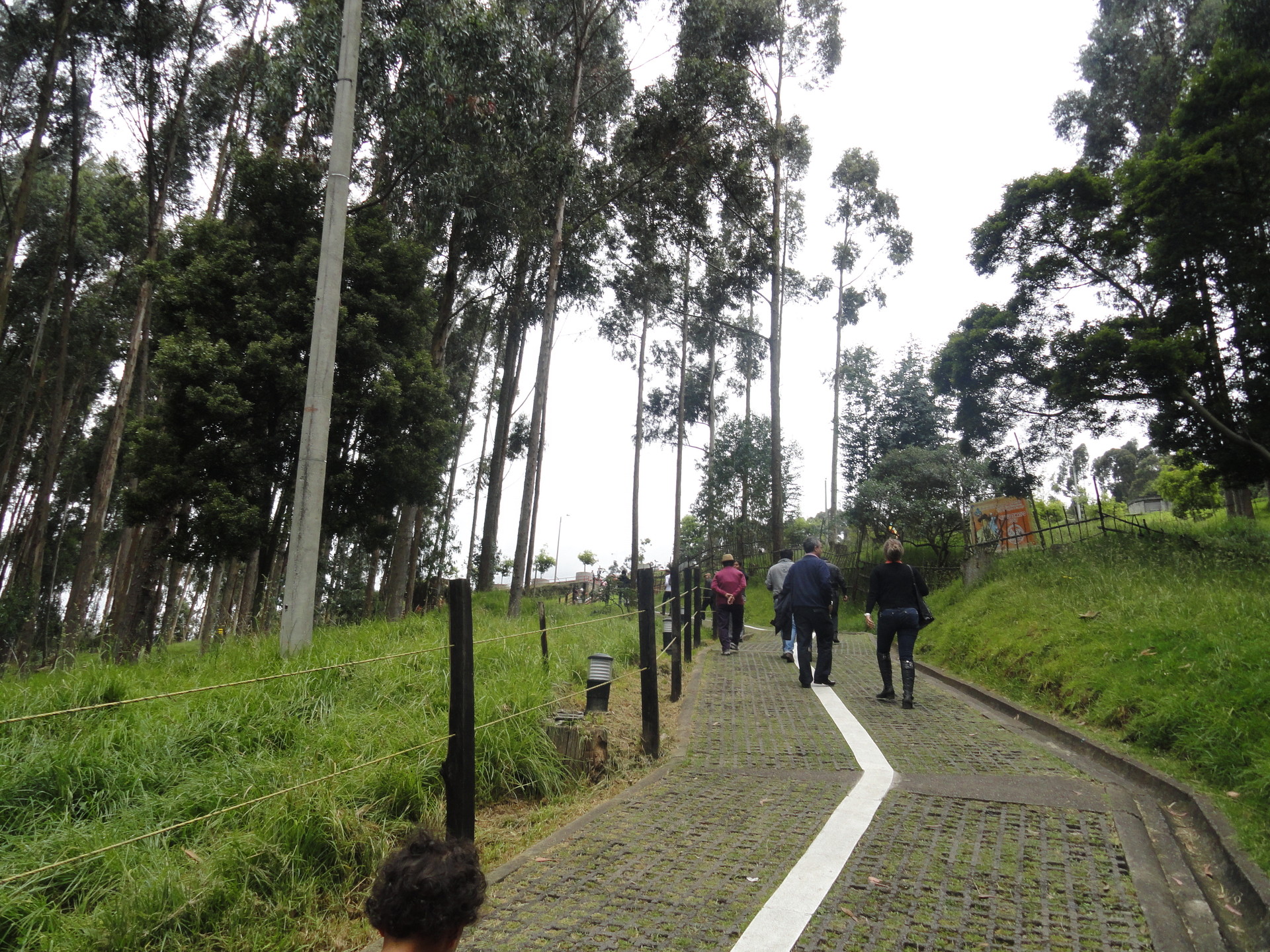
(Here you can see a little bit of the inclined path that you have to walk up to get to the Salt Cathedral. )
Only forty years had passed before the Colombians became more ambitious and began the construction of a new cathedral that would be located in the same place but at a different depth - 60 metres below the original cathedral. The construction of the new cathedral was influenced by the structural problems that the first one had, as well as multiple water infiltrations, although the Colombians say that they wanted a better design than the previous one. The design of the new cathedral was decided by a contest, with the aim of changing many things, both the enclosure itself as well as the entry tunnels, the domes, etc. The design that won was that of architect Roswell Garavito Pearl, who ordered the construction work to begin in 1991, ready for the cathedral to be inaugurated in December 1995.
It's very interesting to come to the Salt Cathedral and learn a little bit about its history, as well as how the miners were able to extract the salt. It's also interesting to learn how and why the salt was formed, with its radical history from the Cretaceous period due to the fact that the sea was located in the Zipaquirá area. A short while later, the water evaporated and left salt deposits behind, which solidified and mixed with other minerals, before remaining in the shape of a stone. There have always been leaks, both big and small, however these are responsible for the formation of white stalactites (tapering structures that hang like an icicle from the roof of a cave) that decorate the place and make it so characteristic.
Nowadays, the quantity of salt that was extracted in the past can no longer be attained. In fact, only 10% is extracted in comparison with earlier periods, but the cathedral produces so much salt that it is enough to satisfy the country's demands, as well as having sufficient amounts left over to export to other countries. It's for this reason that this cathedral is suitable for all types of tourists: it's just as much for religious tourists as it is for those who would like to see the old galleries in the mine that have fallen into disuse and where the cathedral is now formed.
General facts that you have to know before visiting?

(Visiting Zipaquirá's Salt Cathedral doesn't just consist of an entry and an exit point; around the attraction, there is an area with children's play areas and places where you can eat. Outside the site of the attraction, just before returning to Bogotá, we found this fun tree trunk where you can practise rock climbing. Aside from this, there are also games for young children to play. )
What is my budget?
You must bear in mind the fact that the currency in Colombia is the Colombian peso (COP). One dollar is roughly work COL $2496. Don't be put off, it will be very normal for you to see coins with a value of 1000 pesos and even notes up to 300, 000 pesos. Entry to the cathedral costs COL $17000 for children aged 4 to 12, which would work out at around $5. 77. For adults, entry costs COL $25000, or $8. 48. Take into account the fact that these are the current prices and exchange rates in 2018 and, consequently, are subject to inevitable changes. Therefore, it is always advisable to check the current rates before arriving in Colombia.
The only bad thing is that, if you are a foreigner, the tickets will end up being significantly more expensive for you. Entry for adults costs COL $50000, which would work out at approximately $16. 97. At all other tourist attractions, I have always recommended that you buy your tickets in advance through the respective websites because they often give you special discounts. But, on this occasion, I would say that it is better to buy them upon arrival at the cathedral itself, as they usually add an approximate 7. 5% surcharge onto any online ticket purchase, so you would end up spending more money over the internet than you would in person at the ticket office.
You will also have to consider the cost of car parking, which is set at a price of COL $5000 (totalling around $1. 70). There are a couple of toll booths along the highway that you must also bear in mind, however, I unfortunately don't have any further information about these.
When I can visit the cathedral?
Due to the fact that the cathedral is considered to be a touristic museum, its opening hours conform to those of one. The cathedral is open every single day of the week from 9am to 5:40pm, and the tours last for approximately a couple of hours (if you are making your way around at a gentle pace). So, bearing that in mind, I would say that 3pm is probably the latest time that you can arrive to ensure that you can still enjoy the museum in its entirety.
Let's finally start the tour!
It's impressive to learn that the underground cathedral actually sits at the top of a mountain. This simply surpasses everything that we are used to, so be prepared, you will have to climb loads of stairs.
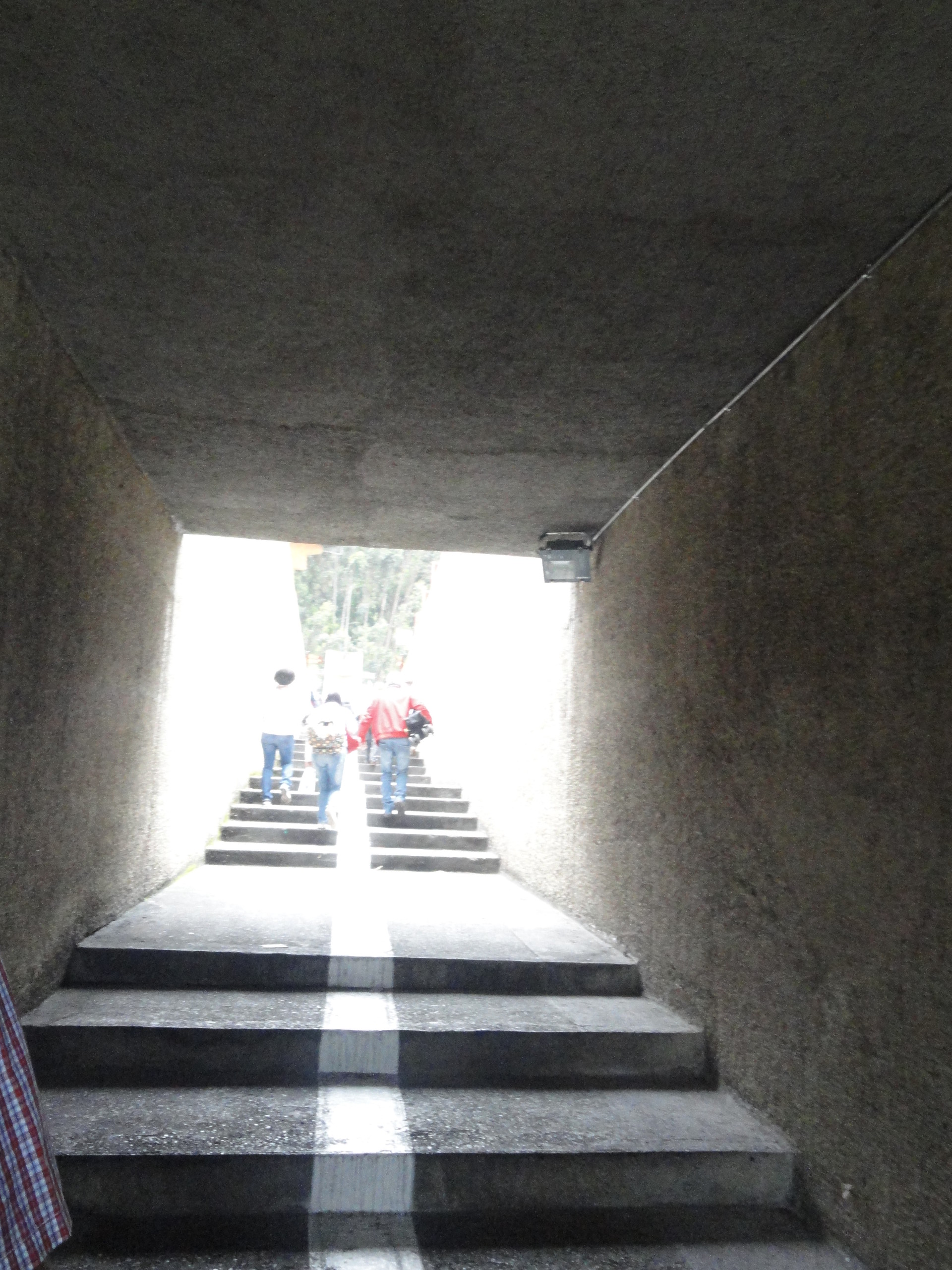
(Some of the stairs that you have to climb up. )
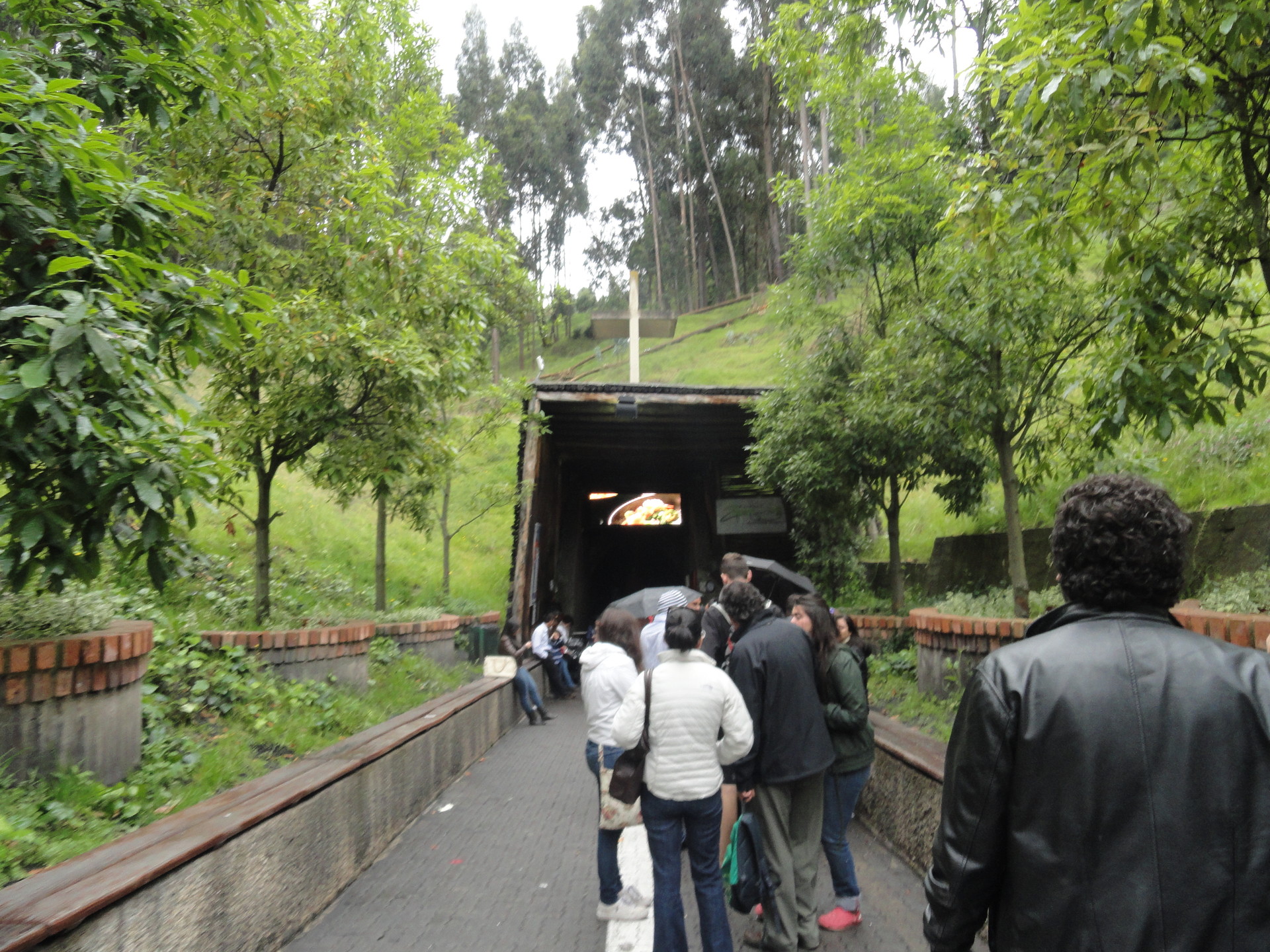
(We were finally arriving at the entrance to the cathedral! )
You will be welcomed to the salt cathedral by a mannequin wearing a miner's suit in honour of those who worked in these old excavations over hundreds of years. As soon as you arrive at the entrance tunnel, you can see light markings along the length of the walls. One of the things that I liked the most is the way that they welcome all of the foreign visitors, especially those that don't speak Spanish.

(The miner mannequin will welcome you to the cathedral. The entranceway seems a little bit narrow given how big the cathedral is on the inside. )
Once you have entered the tunnel, tilt your head back to look up at the ceiling; you will see hundreds of little lights that make different flags of countries from all over the world. Each flag stays there illuminated for all to see in the entranceway for a couple of seconds - it's really nice to go in and find your country's flag up there whilst you are queuing. Aside from the lights for the flags, the entrance tunnel usually has lots of lights and is quite colourful, but as you make your way further into the cathedral itself, everything starts to get a little bit darker. So, with good reason, it's normal to hear some children getting frightened, with some even starting to cry.
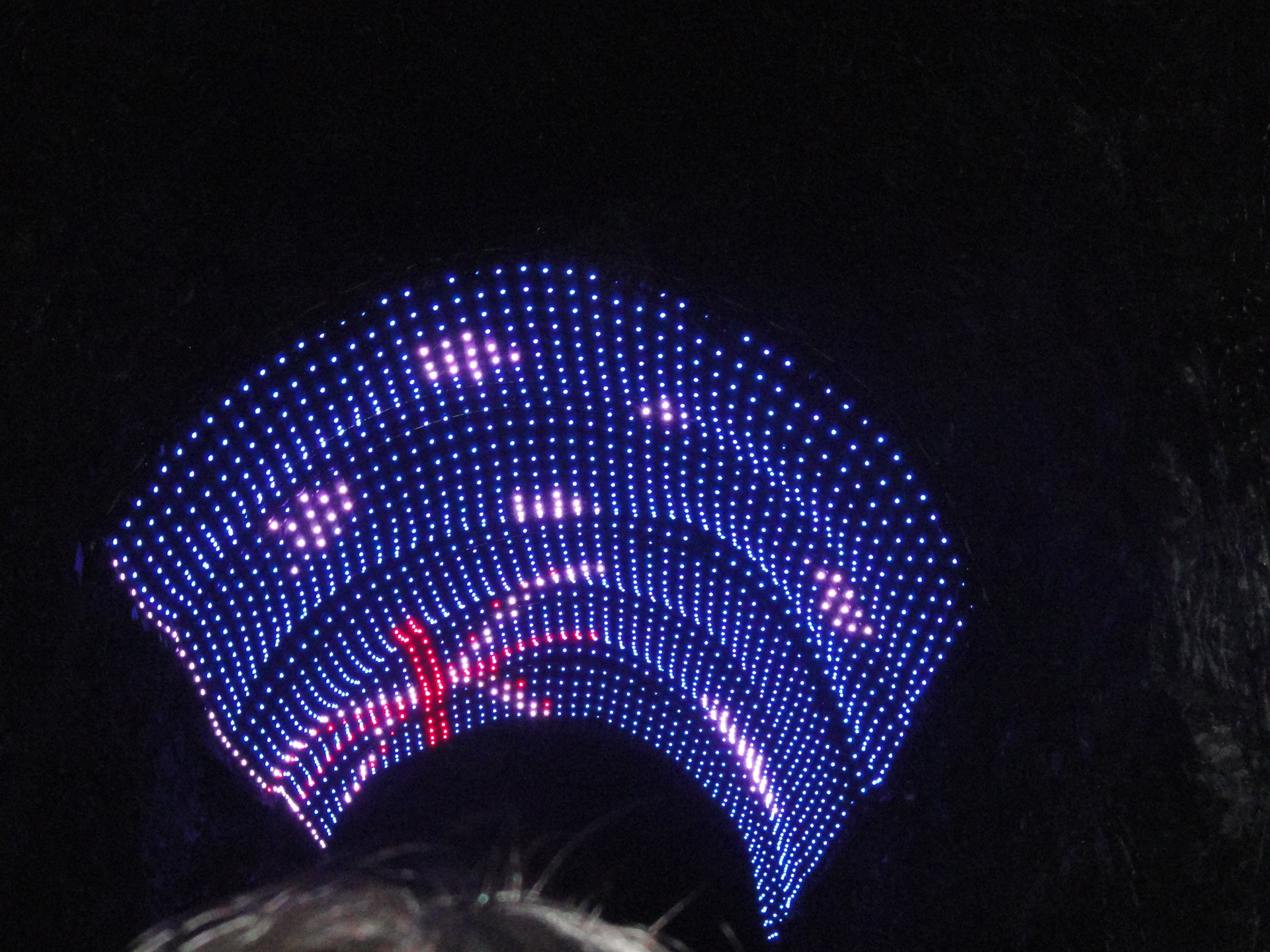
(Here you will be able to see the flags of several different countries. The lights change colour in a matter of seconds to be able to display a different flag. )
The Way of the Cross
One of the most striking sections, and the one that I liked the most, is the so-called "Way of the Cross", which is very large... it's 386 metres in length, to be precise. You are going to have to get used to walking quite long distances, so don't forget to wear comfortable clothing and some sturdy trainers. What is most prevalent in the cathedral is a mixture of light with darkness, beautiful contrasts of the natural darkness of the cathedral combined with the decorative lights, highlighting the numerous rock salt crosses found in the tunnels. These very beautiful decorations were carved by the miners, and although many of them look similar or identical to you, they are not. All of these four sections have a religious representation and, if you get down to the nitty gritty analysis, you will realise that they represent the stages that Jesus lived in the Way of the Cross (which explains where the name came from). For the more religious people, it can be very moving because it reflects the period from the moment of his capture to his burial.
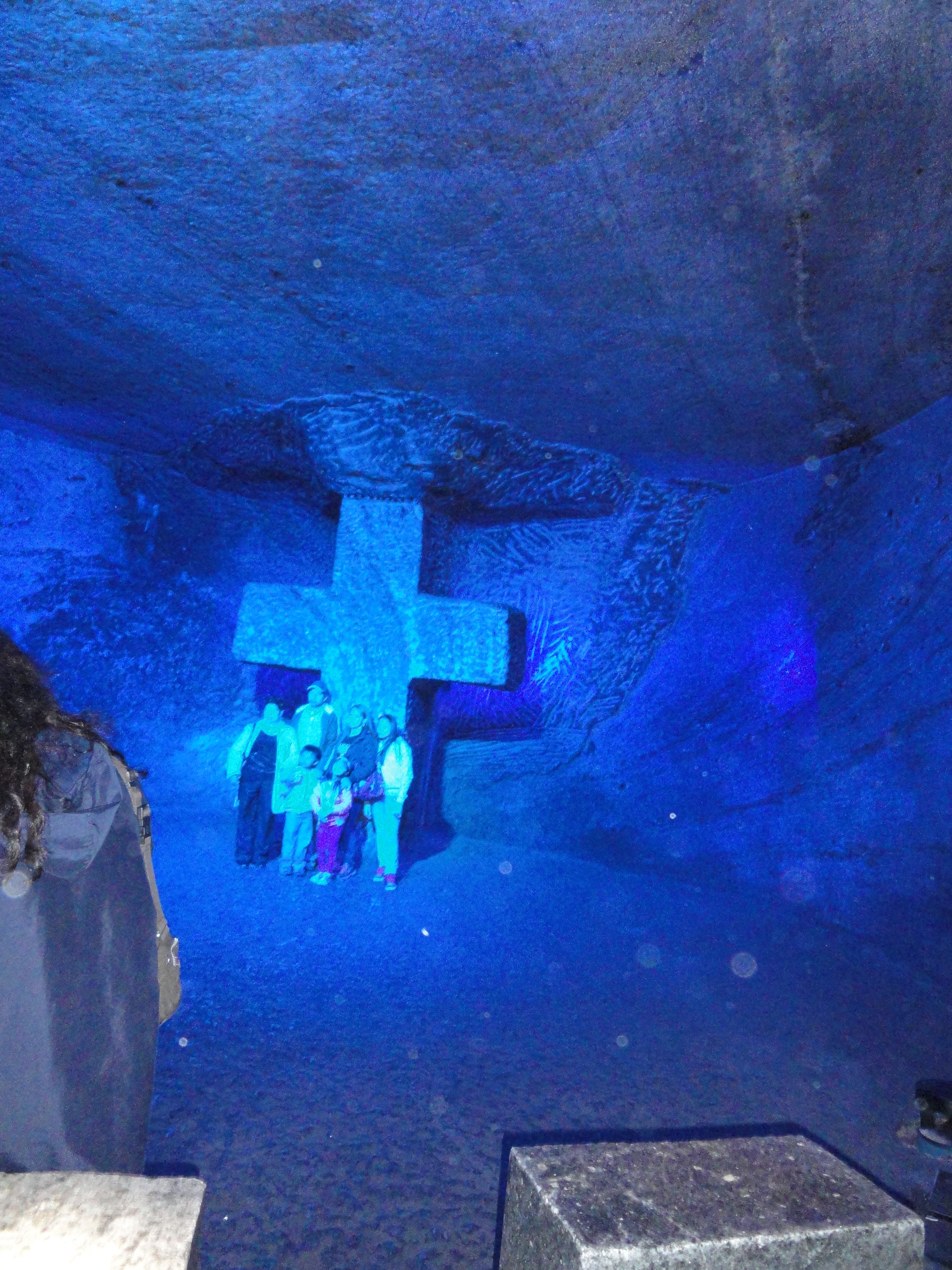
(Here you will be able to see some of the crosses found in the Way of the Cross exhibition. They are all very similar, but no two are identical, as the crosses are either of different sizes, shapes or colours. )
If you are born religious or just come here as a tourist interested in learning more about religion, you will be very happy to know that there are several stone prayer stools in the entirety of this section of the cathedral. They will help you to pray or meditate without leaving the atmosphere of this beautiful salt cathedral. There are lots of figures that you will be able to spot in this section, the majority of which being angels, statues of Adam and God with Adam, and even a nice little Nativity scene. As you will probably guess, these are all carved out of salt and are decorated with nice lights that change colour every couple of minutes, changing between yellow, pink, green, blue, etc.

(One of the salt figures - from the colour of it, you would think that they are made of stone! )
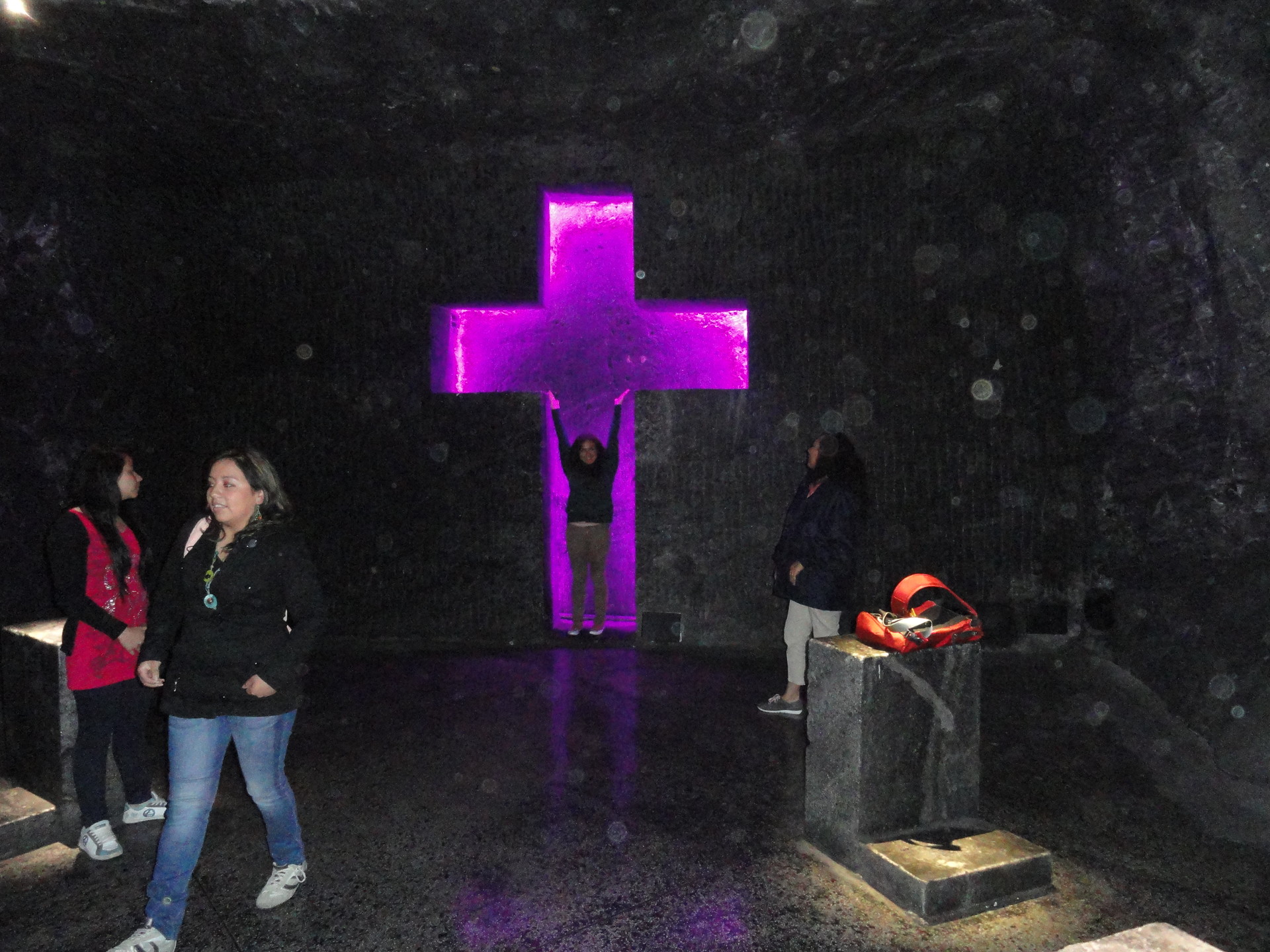
(Here to the right, you will be able to see one of the numerous stone prayer stools found throughout the cathedral. )
For the lucky ones: the choir
When I went, I wasn't lucky enough to see the famous "choir" perform that sometimes sing in the central nave of the cathedral. I have been told that they sing beautifully, but you must pay attention to their performance times on the website. It must be very interesting to hear how they sound in such an acoustic setting, don't you think?
The dome
One of the ways of knowing that you have finished touring around the 14 stops on the tour thus far is when you have arrived at the great dome, which is the main chamber of the cathedral. Here, you will be able to see the biggest carved cross in the entire world. I think that seeing such a beautiful scene before your very eyes is the biggest gift for all of those who decided to visit the cathedral. The cross is found towards the rear part of a huge stone room that measures twenty metres in height, so you will not at all feel suffocated or like you are lacking in space. You should also take into account that it can be a little bit humid and slightly fresh feeling in there, but it never gets to the point of being cold as such.
There will be several wooden prayer stools and other pieces of furniture, making you feel like you are inside a church, except that no mass services are held. Many people usually go down to contemplate the great cross for a short while, which is impressive for even any atheist. I still don't know what it is that gives it that mythical or magical touch, nor do I know if it's for the colours or for being inside something of an immense height below the ground; you simply realise exactly how small we are in comparison to nature.

(And here, you will find yourselves with the largest carved cross in the world. This sculpture marks the end of the Way of the Cross - a perfect place for you to sit down, to pray, to meditate and to ask for things from your heart, like both believers and non-believers do. )
Dare to undertake the mining route at the Salt Cathedral!

(Ready to start the mining route. )
If you want to know what it used to be like working in a salt mine, leave all your fears behind and dare to be an authentic miner, even if it is only for a couple of minutes. Despite the Way of the Cross, the sculptures made out of salt, and the light game all being really impressive, the part of the visit that I liked the most was pretending that I was a real salt miner. The best thing of all is that this activity takes place 180 metres below ground level, and in this area, you won't see any coloured lights, nor will you be standing below a ceiling over 10 metres in height. If you come here with small children, they will not let you bring them on the mining route, as the darkness frightens them too much, but it would be great if you could find someone to watch them whilst you enjoy this activity.
The mining route activity will only take half an hour of your time, costing COL $6000, which would work out at approximately $2. This tour includes the necessary safety equipment - in other words, they provide you with a helmet and a special jacket. In addition to these, you will be accompanied by a guide, who will explain to you what the process of extracting salt from the mine was like in those days. It's really cool to see how everything starts to get narrower and narrower, with the wood having been left to hold up the rock... but there's nothing for you to be frightened about because I can assure you that this is all completely safe!
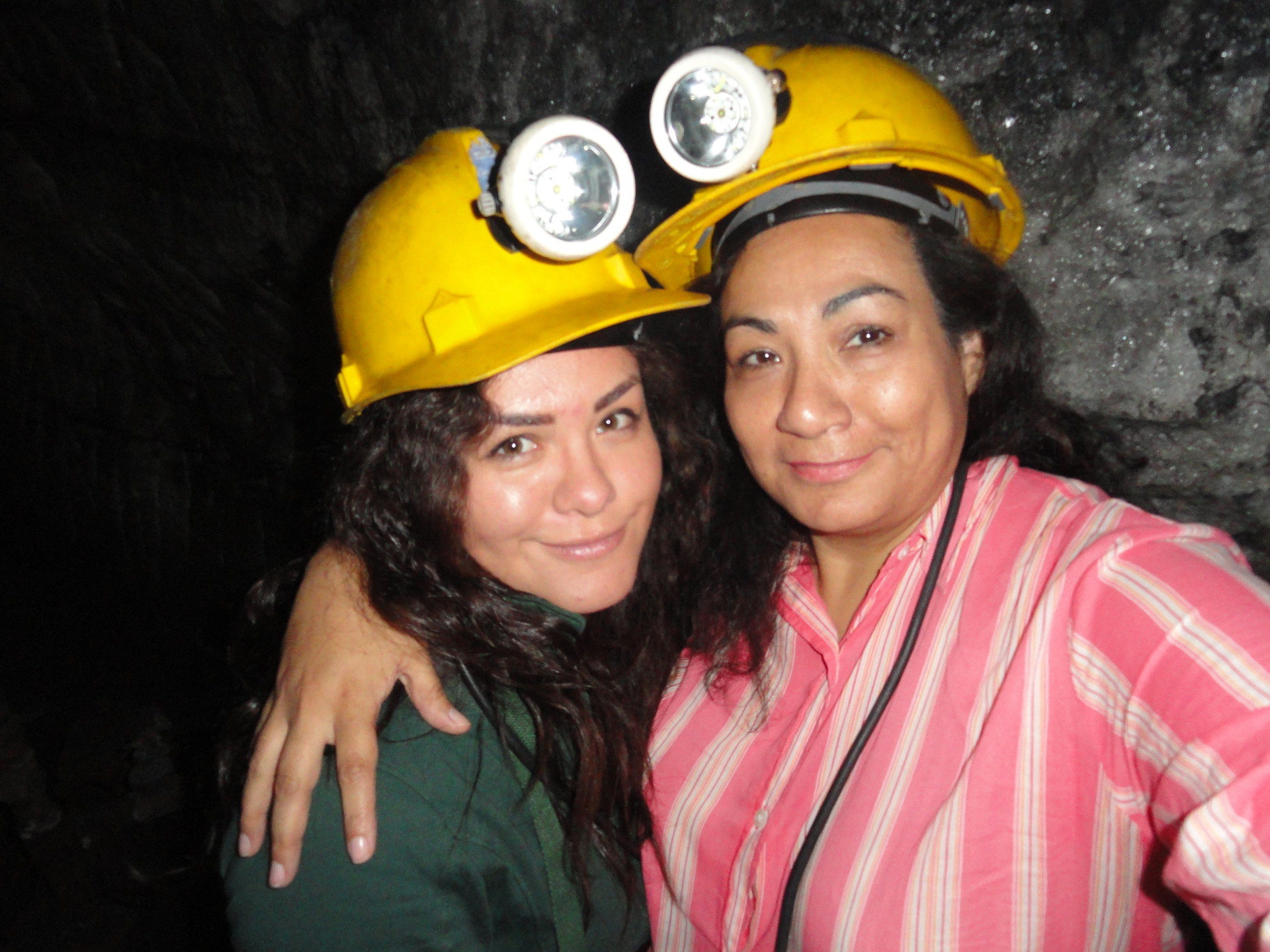
(My mother and I ready to start our mining route - we were quite excited, to say the least. )
On this tour, you will not only be capable of learning about the process of extracting salt from the mine, but you will also even be able to learn how they did it with an axe. At one point during the tour, the guide asks for six to ten people to come forward to help them out with something; I recommend that you are one of the people near the front because these are the people that they pay the most attention to. With the blade in your hand, you will soon realise that, although the salt is all around you, extracting it is not as easy as it seems. I had the opportunity to "extract salt" by just hitting the axe at the wall with sufficient force and it was quite uncomfortable to do so. The salt would fall into your eyes and, despite hitting the axe with more force, only a couple of grains actually fell. It's in this precise moment when you start to truly appreciate the work of these people, which must not be at all easy under these conditions.
Don't leave without buying yourself a souvenir to remember the place by
If you want to show off to your friends that you visited the 'First Wonder of Colombia', you must do so by buying some of the souvenirs on sale here and by taking lots of photos! What better souvenir to take home with you than a gemstone from the mine! Something that you will find quite often in the gift shops inside the cathedral are the Colombian emeralds that are sold at relatively affordable prices. You can find the emerald stone in earrings, rings or necklaces - it definitely makes for a very nice gift, especially for women. If you know that your family probably won't believe you when you tell them that they were angels carved out of salt, why don't you decide to buy them something carved out of salt? In doing so, you are not only taking home a nice souvenir for a loved one, but you are also helping the artisans from Zipaquirá to promote tourism in this beautiful area.
Leave with some good Colombian food
If you want to know what the true Colombian flavours are like, you should be coming to villages like these ones, so you are definitely in the right place in Zipaquirá. You will not only try the typical 'arepitas' and 'plantanitos fritos' [fried bananas], but also food made on the spot. When I saw the restaurant's menu, I really didn't know what to order because I am quite picky when it comes to food, so I decided to choose the most simple item: hen. In all honestly, my thought process was that it must taste the same as chicken does and chicken has a 'standard' taste all over the world. The restaurant's staff told me that my meal was going to take a while to be ready, which I said was absolutely fine, but I didn't expect that when I looked out of the window that I was going to see them killing one of the hens in the restaurant's huge garden in that very moment. I knew that something like that would obviously happen, considering that we were in a village and the restaurants in Zipaquirá are like that, but after living in a city for so many years, it's inevitable that you are no longer used to situations like these... Anyway, I plucked up some courage ready to eat the hen when it came and suddenly it arrived...
Upon just seeing it, I thought that I had to pretend that I hadn't seen them just grab the poor hen by the neck before putting it in front of me on a plate. So, with a big smile on my face and several gestures of satisfaction, I began to eat the hen. Suddenly, I feel a strange taste in my mouth and the insides of the hen began to come out yellow. My eyes widened in shock, and even more so when the owner's wife began shouting in excitement: "How lucky! Your hen has come with a prize! " And if you suspected that this prize was an egg and that the poor hen was, in fact, pregnant, let me tell you that you are indeed correct. It was somewhat difficult to hide my feelings of guilt and disgust after having eaten a cooked egg from the inside of a hen's placenta cooked in a restaurant in the middle of nowhere, but I guess that it helped me to get to know the food culture in Colombian villages to say the least.
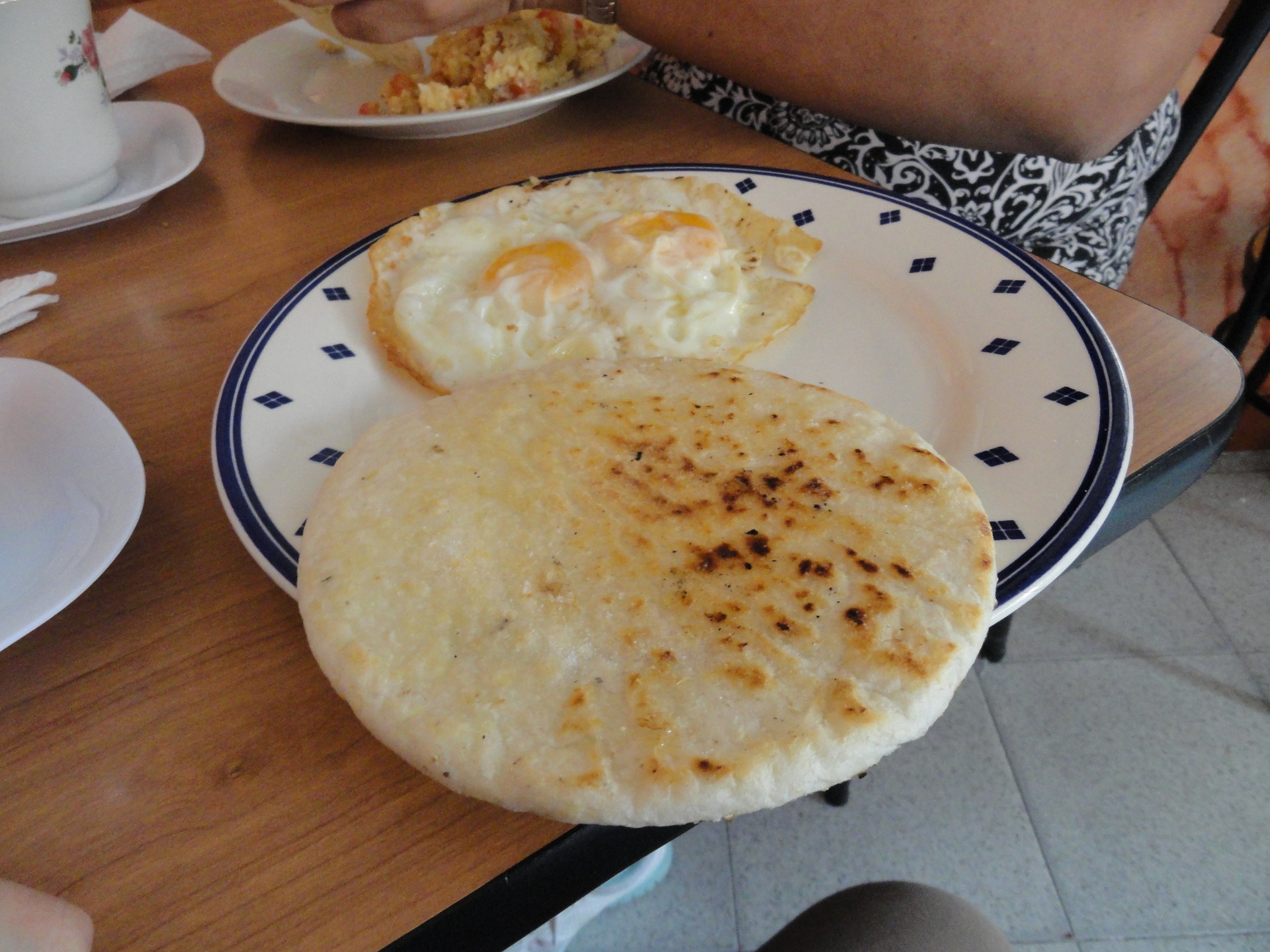
(I was too sad to take a photo of the hen., so I just took a photo of the Colombian arepa that was accompanied by an egg. )
Conclusions
Zipaquirá is a village that I recommend going to if you want to visit a rather original and out of place attraction. Travelling there in a group ends up being cheap and you can take advantage of the time to eat there before leaving. It's a trip that I absolutely don't regret doing and one that I will always remember, however, the local food part wasn't really to my complete liking. Have any of you been to Zipaquirá before? If you have already and had either a good or bad experience, don't hesitate in sharing it with me - it's always very interesting to hear about trips that you have done from different perspectives.
